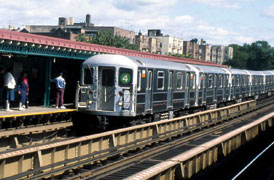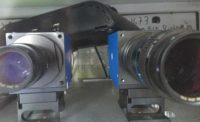 |
| Under Surveillance. Subway platforms will be monitored from high-tech control centers. |
The New York Metropolitan Transportation Authority has awarded a $212-million security contract to a team led by Lockheed Martin to harden its subway and commuter rail facilities against terrorist acts. Officials believe other agencies nationwide may follow suit although transit security funding remains an unsolved problem.
The team includes local firms Slattery Skanska USA Civil Inc. and SYSTRA Engineering. It will install some 1,000 cameras, 3,000 sensors and related infrastructure at "priority locations," says Mysore Nagaraja, president of MTA Capital Construction. These include MTA-operated bridges and vehicular tunnels as well as transit sites.
The plan is to integrate proven technologies such as closed-circuit TV, motion sensors, intelligent video surveillance and perimeter sensors into one seamless system, says Lockheed spokesperson Anna DiPaola. "You will be able to see every kind of alert, where it is in the city and dispatch someone," she says.
At one of several control centers, a staffer will view an aerial map of the city with MTA infrastructure overlaid on it to give a sense of location. Another screen will allow the viewer to zoom in on a specific site, such as a platform. Audio and visual alerts will go off when suspicious activity is detected. The staffer will be able to identify the type of activity and pinpoint its location. Setting parameters may aid in deterring false alarms: An operator may program a time limit for a backpack left unattended before an alert goes off.
The system can be expanded to include additional technologies, such as biochemical detection and explosion detection. "We will hook in other locations as we get more money," says Nagaraja. "We still hope to get transit security funds from the Dept. of Homeland Security." The contract is funded from $591 million allocated in MTAs 2000-2005 budget cycle for security.
Bethesda, Md.-based Lockheeds team is one of three that prequalified in February, well before Londons July 7 bombings. "The goal was always to award the contract before the end of August," Nagaraja says. "London happened in the meantime."
The initial three-year contract includes maintenance options that could extend the program through September 2013. "Were building command-control-communications centers for each agency, plus a central one in Long Island City," says Nagaraja. Subcontracts will be forthcoming to install fiber-optics systems and cameras and build control and communications rooms, he says.
Priority
The contract represents the largest of MTAs 57 "priority" projects, created from vulnerability assessments done after Sept. 11, 2001, Nagaraja says. The MTA has another $500 million in its current budget cycle for security work.
Nagaraja has discussed the program with other transit agencies, though none apparently yet have plans on the same scale. "Weve talked to the Los Angeles MTA about security," says Bill Sewell, senior vice president with DMJM H&N, Los Angeles. "Security is on the minds of lots of agencies...but funding tends to be the thing that stands in the way."
He notes that "transit presents difficult challengesthe primary one is that when you look at security, transit has 32 times as many passengers as an airport in a day." New Yorks MTA rail systems carry 2.4 billion riders annually.
Earlier this summer, the U.S. Senate slashed $50 million from proposed $150-million transit security grants in the homeland security budget. It did not
overturn this decision despite the London bombings (ENR 7/25 p.12). "We are spending $9.58 per airplane trip for security, but three-tenths of a penny for each transit trip," says Jim Tucci, of Tampa-based K&J Consulting Services.
K&J is providing security consulting on MTAs East Side Access project, where the challenge is to design for future integration of emerging technologies. "Were trying to engineer-in technology that we know is comingrapid body scanners, sensors that smell chemicals on a persons body," he says. "Were beyond the days of an 8-ft-fence."




Post a comment to this article
Report Abusive Comment